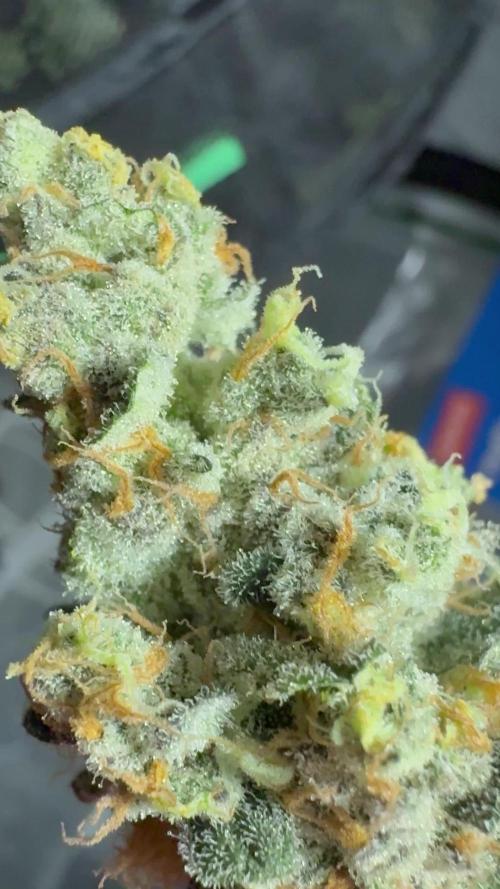The Grow Awards 2026 🏆 























Likes
Comments
Share


@blacknpearl
Follow
dec 6. megacrop 1.06gr/litre ph'ed at 6.28. ~500 ml
dec 8. megacrop 1.06gr/litre ph'ed at 6.28. ~500 ml
dec 8. pretty heavy defoliation and some light LST
dec 10. megacrop 1.06gr/litre ph'ed at 6.35. about 500 ml
LED is about 85%
Processing
Likes
4
Share


@WeedDoctorSam
Follow
I finally got a new certified TDS monitor and figured out that my last one was cheap and unreliable. I'm getting much better readings for this part of the veg cycle (600-700).
Running pH a little on the high side to rectify what I thought might have been a slight magnesium deficiency caused by pH Down-ing the shit out of it before I went on vacation (got down to like 5.5 which I figured would fix itself as alkalinity levels in the water rose).
This week I finally proceeded with the first of the mainlining steps outlined in the Nebula Haze tutorial on Grow Weed easy. The plants are freshly topped and their remaining growth tips are tied down. Now we wait and see how they respond in week 4!
Likes
18
Share


@maneaura
Follow
i went on vacation like 10 mins after this. i dont have any pics of the painkiller for this week.
Likes
61
Share


@Roberts
Follow
So I am harvesting sweet Bourbon Kush Autoflower. It grew really fast. It smells like a wooddy sweet Bourbon. Hence the name. 🤷. She grew great for me in coco/perlite in a 1.5 gallon Potter. She has a great smell, great frost. Looks delicious. I am super eager to try the results. Thank you Spider Farmer, and Super Sativa Seeds Club. 🌱🤜🏻🤛🏻🌱❄️🌱
Thank you grow diaries community for the 👇likes👇, follows, comments, and subscriptions on my YouTube channel👇. ❄️🌱🍻
Happy Growing 🌱🌱🌱
https://youtube.com/channel/UCAhN7yRzWLpcaRHhMIQ7X4g
Processing
Likes
19
Share


@lukavega
Follow
Day: 9 I'm considering replacing a cpl of these with different seeds. They are already behind schedule-1 OG Kush and the Gorilla Girl. Any tips varigation on leaves? I just gave them there first feeding of Big Buds and Blooms (N5) after the 24 hour Superthrive wait period. Both Superthrive and NPPK were used at 1/4th the strength called for on the lable. Nighty Night girls. Going to bed wet is not ideal but they needed a full watering bad..hoping I didn't over water (purified water) Some of the soil just does not seem to get wet in these pots. weak leggy blackberry kush has some wind tonite. Hoping to boost stem strength. they are trying to fall over from the weight.
Day 10: made little stakes from coated wire. Repositioned the Gorilla Girl for a third time. You can see that part of the stem looks white from being underground. Still gonna give it a little more time. Otherwise, all are seemingly fine after first feeding.
Day 11: applied SuperThrive and my Gorilla Girl turned yellow for a few hours. Glad she is resilient!!!
Day 12 thru 20. So my PH meter was wrong and I have been watering with 9+ water for the first 2 weeks. i had 2 ph meters in case this happened but one is for soil...new grower mistake. So...I've lost precious time on my aotos and my gorilla girl is ...lord help meh..she don't look too good. All are alive in spite of my noobness. I'll post some pics that should have a disclaimer stating this is not what your plants should look like at 20 days in. Also had to transplant into non-waxlined pots. This is not the best experience to show publicly but new growers can maybe learn from my mistakes.
Likes
54
Share


@Baked_in_the_Bluegrass
Follow
Week 6 is in the books and it was another great one.
Both plants are finishing stretch and building budlets.
Still super green and healthy tho there are a few signs of some heat stress.
Nothing worrying at all yet, after the heat that everyone really has been dealing with it’s not surprising to see a few leaves a bit roughed up.
I went out of town for a few days and while I did have someone able to cover most of the feed/waterings the gals did go a day and a half without any.
No biggie tho, they’re shrugging it off and just rocking along!
Beefy burly plants here, and I’m guessing anywhere from 4-6 weeks to the finish line.
Likes
27
Share


@Stealthman
Follow
The plant of course is much more smaller with the restricted root zone causing a bonsai effect. However, she performed really well under the circumstances with a relatively large yield all things considered. I usually smoke high CBD but was very impressed with this high. Let's see how it goes after spending more time under the influence.
Review...
Growing in the solo cup sized container proved to be much more challenging than a regular grow. The plant soon became stressed dealing with the tiny root zone making everything hyper sensitive. The first issue was showing as tip burn even though the ppm was kept in the 650-850 range. Then the leaves showed a general yellowing overall specially showing at the bottom fan leaves. At this point I was changing the nutrient solution every 2-3 days trying different nutrient brands and concentrations seemingly without much success. It was a nerve wracking period which ultimately lead me back to General Hydroponics with amendments. I did learn that the plant can weather the storm even with less than perfect vegetative leaves while she focuses all her energies into calyx production. It’s was upsetting to see less than stellar health but eventually all the leaves drop and the flowers power on seemingly without issue.
The cascading diamond structure developed as a result of a couple broken branches that occurred during the training process in an effort broaden the plant profile with wider lateral spacing. Although initially upset when the fractured branches that withered after being bandaged up and . After removal of said branches it was exciting to see the new possibilities. The cascade formation called for additional side lighting to maintain uniform bud size all the way down the front lower end of the plant. I was looking to create a stadium like effect.
The experience of operating the visual hydroponic unit called for a number of practical adjustments along the way. Although initially, very excited with the system concept as an integrated design with nutrient solution supply and gravity drain through the pump, with the air supply inside the pipe with the air bubbler acting as the drain/root filter... in hindsight, obviously, it would not work as the root mass became denser and denser. The first issue, as the path of least resistance, the air was forced back down the nutrient supply pipe. This prevented the pump from priming itself and subsequently no nutrient solution delivery was even possible. As a result, the original air stone was left in place to prevent the roots from entering the nutrient tank and a new bubbler stone simply added to the tank itself.
Although the original idea was for the air to be continuously pumping directly through the roots, the flood and drain would actually be just as good when drawing the fresh air in and out with each pump/drain of nutrient solution. The ON cycle was initially set to 10 seconds which eventually became 30 seconds as the roots mass grew denser. This proved to be too unreliable as the fill level was no longer consistent which required constant monitoring to be sure that there was no flooding over and above the container lid. It which case, a simple feeder tube to the top of the root zone was the best option. The ON cycle was set to 5 seconds with a 15 minute OFF interval. Overall the biggest concern was the timer itself, which had several bad reviews for malfunctions with growers losing their plants. However, I have no choice as this was one of the few timers that was capable of cycling down to the second but it all workout fine in that regard… no problem.
Was it a perfect grow?... no, definitely not. However, as a relative beginner, it was definitely a great learning experience. Mostly, I need to work on the nutrient blend and concentration. For more control, a backup tank with float valve delivery to maintain the water level for this particular system would be a good idea as well.
Likes
7
Share


@sunshinegroww
Follow
She now starting to packing these flowers and lol smells so sweet its amazing really nice steuctured plants ,not very thirsty on nutrients ,removed some yellow 🍁
Likes
118
Share


@SwissKush
Follow
Day 8 - very healthy sprout
a. the roots are already into the pool, forming ladder roots
b. I changed the DWC out, always from top watering you will get some gunk in there from the root riot/hydro rock dust, tends to build up on the roots, it never hurts anything, however it couldnt be good for the nutrient absorption.
c. water source is mountain water, 130ppm from spring.
d. TS1000 is at 100% intensity at 75cm away from the top, they love this
day 9 - growing fast
a. she is growing fast, and the roots are developing nicely
b. keeping the ph 5.8-6
Day 10 - looking very nice
a. this seedling is very healthy, strong
Day 11 - growing fast
a. this is a very fast plant, having to keep knocking the PH down
Day 12 - growing very well
a. had to move her to the corner of the tent to make way for my Afghan kush plant, it got too cold out in our barn for the Afghan kush
b. the seedling is growing very well, she still gets a good amount of light
Day 13 - growing well
a. she appears to be growing fine despite her tent mate
b. will be nice to move the Afghan out of here next week when it is supposed to get warmer
Day 14 - nice environment
a. the Afghan Kush and the Big Bud are friends now, lol
b. all is growing well here
c. video of our friendly environment
Likes
7
Share


@Athos_GD
Follow
D22. Defoliated, gave plain RO water and dimmed the light. Next is auto irrigation.
D23. Finally received all of the Athena nutrients and fed for the first time.
D25. Removed the small runt plant with the twisted stem. The plant started growing pollen sacks.
D26. Raised light as much as I could without using zip ties. PPFD now 650-790. EC tonight 2.4.
Processing
Likes
36
Share


@Island
Follow
Week 4
Broad Mite still making victim.
On this week I watered she with water + diatomaceous earth
Still waiting for better days, I hope hv succes 😐
Apparently the diatomaceous earth is working against broadmite 😅
Processing
Likes
34
Share


@ElLocoDeLaHabitacion420
Follow
some colas have been growing taller than the others I really dont want to keep adjusting them to the same high! I think im going to leave her be! and see what happens. started feeding her bc bloom to estimulate flowers I really dont know what to expect from her! I just hope im doing it right





























